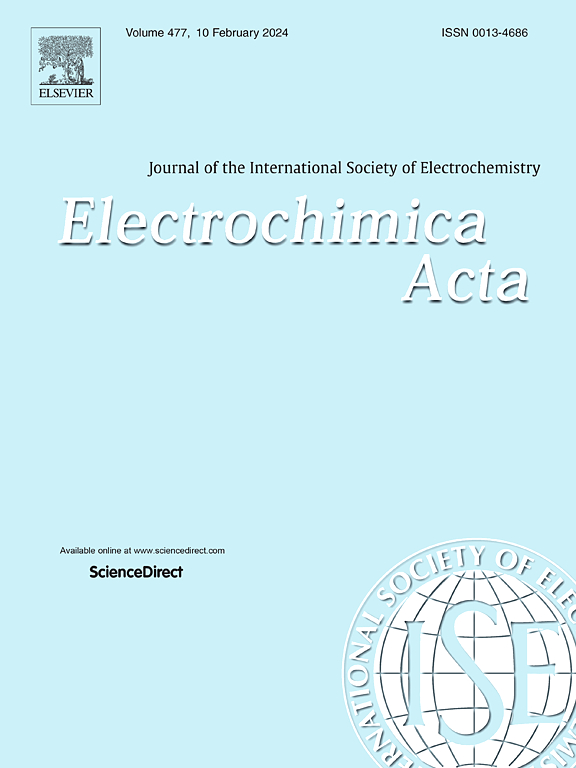可变粘度和扩散率以及施密特数对旋转半球电极附近稳态流体力学场和浓度场的影响
IF 5.5
3区 材料科学
Q1 ELECTROCHEMISTRY
引用次数: 0
摘要
本研究的重点是电化学电池中旋转铁半球电极周围形成的稳态边界层。电极材料溶解到电解质溶液中,伴随着电流通过电路,会产生一个浓度边界层,该边界层明显比流体力学边界层薄,这主要是由于实际应用中典型的高施密特数。该边界层内溶液成分的变化导致电极表面附近的流体粘度增加,电解质的扩散系数降低。先前的研究表明,除了在电极表面附近形成浓度边界层的空间区域外,径向速度剖面与在具有恒定粘度和扩散系数的电解质中观察到的速度剖面相似。与具有恒定特性的溶液相比,这种差异会改变壁面的速度梯度,影响扭矩、质量通量以及最终的传输限制电流。这项研究进一步探讨了施密特数和电解质粘度比(电极表面粘度与溶液体积粘度之比)的影响,以及斯托克斯-爱因斯坦定律规定的相关扩散率变化。施密特数在确定浓度边界层和流体力学边界层的相对厚度方面起着重要作用,影响着电极溶解引起的电流流动。根据边界层概念推导出的近似方程组采用径向和极角坐标的有限体积法求解。这种方法产生了一组代数方程,用于计算三个速度分量的离散剖面和每个极角处的浓度。该近似值在层流的高雷诺数下有效,通常在 RHSE 中会遇到,即低于湍流过渡临界值。Acta 450 (2023) 142236)。本研究的新颖之处在于使用了不同的方法来离散和求解边界层方程,从而可以探索比以前更广泛的施密特数、粘度比和极角范围。研究结果加深了对电化学电池中旋转铁半球电极周围稳态边界层动力学的理解,并强调了施密特数和粘度比对这些系统内传输过程的重要影响。本文章由计算机程序翻译,如有差异,请以英文原文为准。
Effect of variable viscosity and diffusivity as well as Schmidt number on the steady-state hydrodynamic and concentration fields near a rotating hemispherical electrode
The focus of this research is on the steady-state boundary layer that forms around a rotating iron hemispherical electrode in an electrochemical cell. Electrode’s material dissolution into the electrolyte solution, accompanied by the current passage through the circuit, generates a concentration boundary layer that is significantly thinner than the hydrodynamic boundary layer, primarily due to high Schmidt numbers typical for practical applications. The change of the solution composition inside this boundary layer leads to an increase in fluid viscosity near the electrode surface and a decrease in the electrolyte’s diffusion coefficient. Prior studies have indicated that radial velocity profiles are similar to those observed in electrolytes with constant viscosity and diffusivity, except for the spatial region near the electrode surface where the concentration boundary layer forms. This difference alters the velocity gradient at the wall, impacting the torque, mass flux, and ultimately the transport-limited current compared to solutions with constant properties. This research further explores the effects of the Schmidt number and the viscosity ratio of the electrolyte (the ratio of the viscosity at the electrode surface to the bulk-solution viscosity), along with the associated diffusivity variations prescribed by the Stokes-Einstein law. The Schmidt number plays an important role in determining the relative thicknesses of the concentration and hydrodynamic boundary layers, affecting the current flow due to electrode dissolution. The set of approximate equations, derived from the boundary layer concept, is solved using the Finite Volume Method in radial and polar-angle coordinates. This approach yields a set of algebraic equations for the discretized profiles of the three velocity components and the concentration at each polar angle. The approximation is valid at high Reynolds numbers for laminar flows, typically encountered in RHSEs, i.e. below the turbulent transition threshold This study is based on previous work where the same set of equations was solved using the power series method (Electrochim. Acta 450 (2023) 142236). The novelty of this study consists in the use of a different method to discretize and to solve the boundary layer equations, which allows for the exploration of a broader range of Schmidt numbers, viscosity ratios, and polar angles than was previously possible. The findings enhance the understanding of steady-state boundary layer dynamics around a rotating iron hemispherical electrode in an electrochemical cell and highlight the significant impact of Schmidt number and viscosity ratio on transport processes within these systems.
求助全文
通过发布文献求助,成功后即可免费获取论文全文。
去求助
来源期刊

Electrochimica Acta
工程技术-电化学
CiteScore
11.30
自引率
6.10%
发文量
1634
审稿时长
41 days
期刊介绍:
Electrochimica Acta is an international journal. It is intended for the publication of both original work and reviews in the field of electrochemistry. Electrochemistry should be interpreted to mean any of the research fields covered by the Divisions of the International Society of Electrochemistry listed below, as well as emerging scientific domains covered by ISE New Topics Committee.
 求助内容:
求助内容: 应助结果提醒方式:
应助结果提醒方式:


